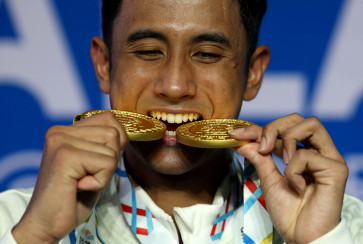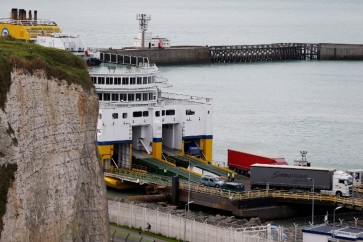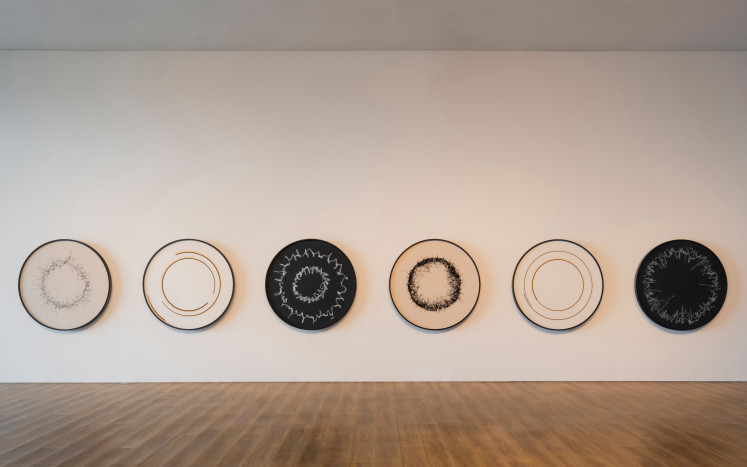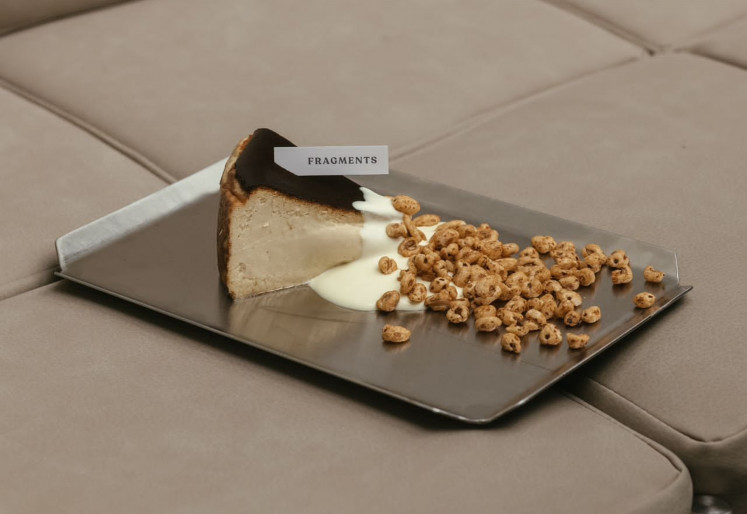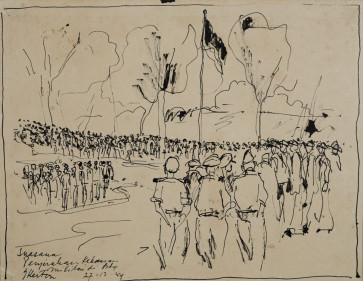Popular Reads
Top Results
Can't find what you're looking for?
View all search resultsPopular Reads
Top Results
Can't find what you're looking for?
View all search results‘The Hidden Treasures of Sudjana Kerton’: Remembering for tomorrow
Amid today’s digital art surge, the exhibition, running from June 11 to 26, invites us to reflect on Indonesia’s history through his powerful, timeless works.
Change text size
Gift Premium Articles
to Anyone
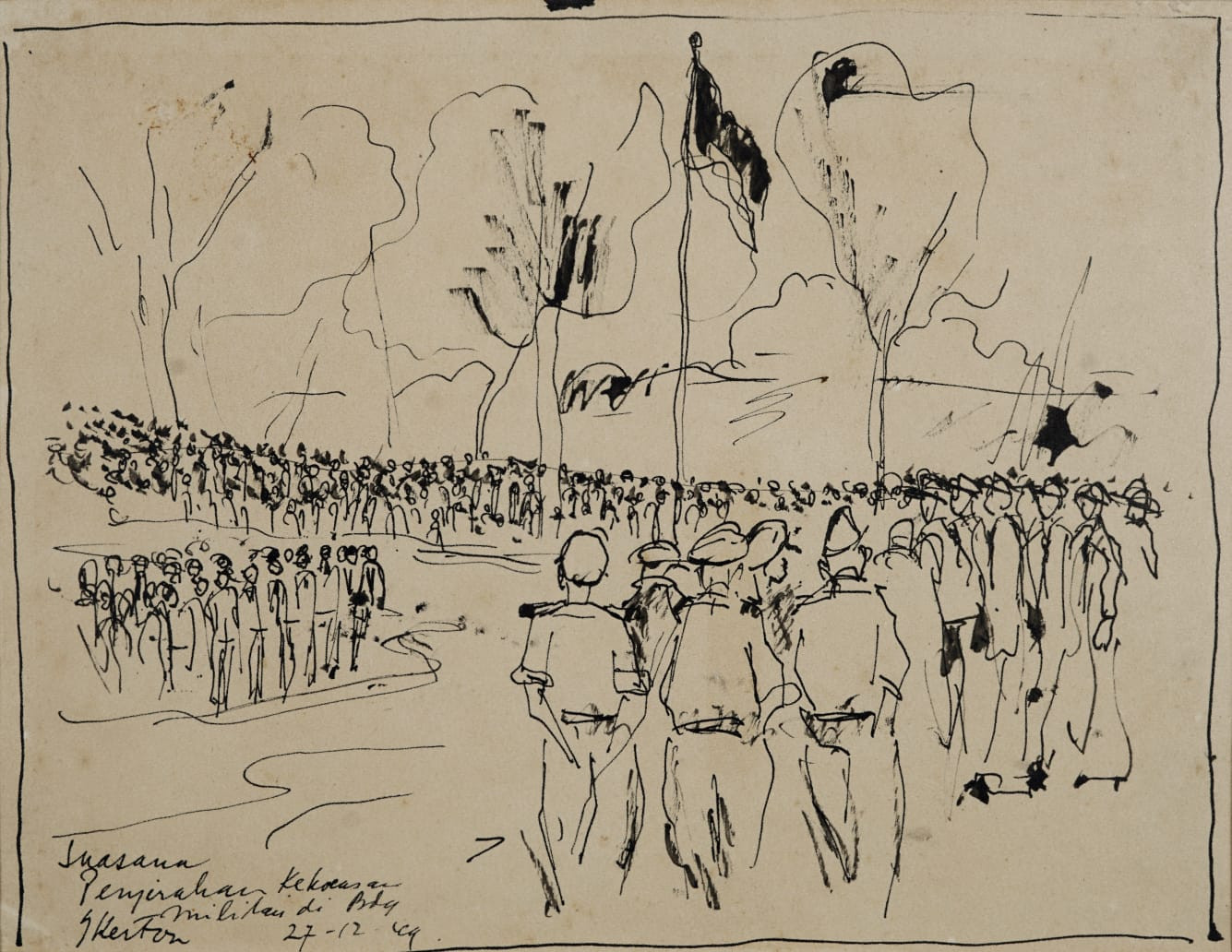 Historic trace: A photo of a sketch created by Indonesian artist Sudjana Kerton, entitled 'Soeasana Penjerahan Kekoeasaaan di Bandung', which loosely translates as 'A scene of transfer of power in Bandung'. The sketch was made in 1949 and measures 25.2 x 32.6 centimeters. The art is on display during “The Hidden Treasures of Sudjana Kerton” exhibition at Art:1 New Museum in Jakarta, from June 11 to 26, 2025. (Indonesia Art Documentary/Adi Rahmatullah)
Historic trace: A photo of a sketch created by Indonesian artist Sudjana Kerton, entitled 'Soeasana Penjerahan Kekoeasaaan di Bandung', which loosely translates as 'A scene of transfer of power in Bandung'. The sketch was made in 1949 and measures 25.2 x 32.6 centimeters. The art is on display during “The Hidden Treasures of Sudjana Kerton” exhibition at Art:1 New Museum in Jakarta, from June 11 to 26, 2025. (Indonesia Art Documentary/Adi Rahmatullah)
I
n an era dominated by ever-evolving technology and a contemporary art scene shaped by digital tools and scientific advancements, it is easy to overlook the enduring power of artworks rooted in the past. Yet “The Hidden Treasures of Sudjana Kerton”, now on view at Art:1 New Museum in Kemayoran, Central Jakarta, offers a compelling reason to pause, look back and reflect.
Running from June 11 to 26, this special exhibition brings the legacy of Sudjana Kerton (1922–1994) to new light. It serves not only as a reminder of his artistic achievements but also as a testament to the resilience of the human spirit, the weight of memory, and the deep imprint of Indonesia’s formative years.
Kerton’s body of work spans sketches, drawings, prints, lithographs, woodcuts and paintings. These were produced using the most accessible materials available at the time, decades before the convenience of digital photography or modern printing methods. In their simplicity lies their power. Each line and brushstroke carries the urgency of moments too important to forget: a nation in flux, a revolution in motion and a people in the process of defining themselves.
Born in Bandung, West Java, Kerton initially trained as a draftsman, but his career quickly evolved into something much more layered. As an illustrator and journalist, he contributed to newspapers such as Patriot and Orientatie. This dual identity, artist and reporter, proved crucial during Indonesia’s struggle for independence from Dutch colonial rule. Relocating to Yogyakarta, Kerton began working as a frontline illustrator, capturing political developments and battlefield scenes in real time.
He often accompanied President Soekarno, documenting public appearances and closed-door meetings alike. His pen and ink sketches from this period are particularly striking: raw, immediate and deeply human. There are soldiers with hollowed eyes, their exhaustion written across every line of their faces. There are quick battlefield sketches, etched with precision and emotion, depicting the intensity of revolutionary moments. These artworks did more than record history, they felt it.
After independence was won, Kerton’s artistic journey expanded beyond Indonesia’s borders. Awarded a scholarship, he traveled to the Netherlands and France. Later, he visited the United States and Mexico, where he encountered the bold, socially engaged murals of Diego Rivera. That encounter sparked a profound resonance. Kerton absorbed the vibrant political artistry of Rivera and others, infusing it with his own sensibilities rooted in Indonesian soil.
Although Kerton spent more than two decades abroad, his heart never left his homeland. In fact, he remained deeply connected to Indonesia and its people.


